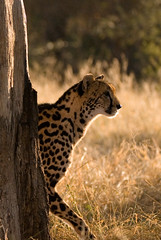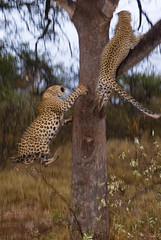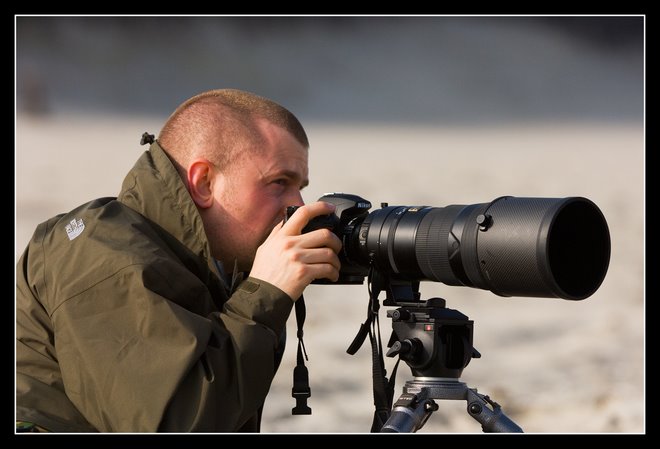Now, in my opinion, there are three main things that flash can be used for in digital photography - i) providing light where there isn't enough ii) providing fill light for heavy shadows, and iii) stopping the action.
When I don't have enough light in the wild, it is generally time to call it a day and go home, as the effect you get by trying to light up the darkness (especially at dusk) is very artificial, and doesn't really work (*), but the other two situations lend themselves to flash very well.
There are a number of ways you can use flash to provide fill. Firstly, as in the case with the cobra photograph here, a small flash will take the darkness out of the shadow areas on a subject, and provide just enough light to make the subject pop. With animal photography, this light will normally have the added bonus of a catchlight in the subject's eye. In these sort of situations, I will set the camera in aperture priority mode to provide the appropriate amount of depth of field, and use a spot of negative flash exposure compensation, normally around -1 to -1 2/3 stops so that the flash doesn't overpower the shot.

A second example of using fill is shown in the king cheetah shot. Here, the subject is backlit, and a normal exposure would leave the cheetah's face in shadow, however by using fill flash, the SB-800 automatically works out the correct amount of illumination to get the exposure correct.
The third example of using flash is to stop motion. Because the duration of a typical flash is very short (anywhere from 1/1000 to 1/50000 of a second) it can be used in combination with a slower shutter speed to freeze the action in a frame. I used this method in my shot of the leopards in the tree to give the viewer the impression of movement in the frame. Here I chose a slow shutter speed (around 1/50s), together with flash. Then during the shot I panned the movement of the leopards ascending the tree. This gave the result that the background was blurred, due to my panning, but the short duration of the flash froze the action of the animals, giving a dramatic image. The ghosting behind the animals also adds to the image. Note that if you do want to have movement 'streaks' behind the subject, it is important to set the flash to rear curtain sync, so that the flash freezes the movement at the end of the exposure, as oppose to the start of the exposure (which would lead to the blur being in front of the subject)

The use of flash is a very creative tool in modern day photography, and is a skill that I am only just starting to appreciate. If you have an opinion on this, I would love to hear it......
(* there are definitely situations where the use of flash in complete darkness can be useful, but this typically requires a little more thought than simply placing the flash in the hotshoe, and is not a situation that I have had the chance to be in yet)







5 comments:
I love the leopards! How long did you wait to get that shot"
www.big5photosafari.com
Wow, this is really interesting. I just clicked thru from flickr, and you're addressing an issue here that I'm just starting to have. I've been shooting outdoor landscapes and adventure photography for a year or so now, and I just bought myself a flash in the hopes that I might lift some of the shadows in my climbing shots.
How often do you adjust settings for your flash? Do you leave it in the hotshoe or move it around for better direction? Do you use a diffuser at all?
I kind of feel lately that I've started over from scratch with this , and it's intimidating. I'll link to your blog and check back for advice.
Thanks! - Kate
(colocalders.com)
Hi Kate,
Thanks for the comment. Whether I adjust flash settings really depends on what I am shooting. Most of the time, I adjust settings on the camera, and then let the flashgun do its own magic. I do find however that when I am using it during the day for relatively close subjects, I need to underexpose the flash compensation between 1 and 2 stops - experimenting normally finds me th right value.
The settings on the camera are more important, as this is where I can determine if I am going to use slow sync, rear shutter sync, etc.
What is also important, especially when shooting action, is to adjust the top sync speed within the camera config menu. I saw you shoot with the D70, and can't remember exactly what the top limit is there, but i think it is 1/250s. With the D200 that I use, it is possible to sync at any speed (or at least the camera will try and sync the flash), which can be very useful.
For 'action' I typically leave the flash in the hotshoe - the main advantage of using a bracket is to get rid of shadows and redeye on people, so not needed there. If I had the time to set things up, there are definitely occassions when setting up off camera would be nice, but with wildlife photography, I generally don't have the time.
For portrait/people photography, I also use the flash in the hotshoe, but use a Gary Fong Lightsphere, which is basically a glorified diffuser, and gives me a really nice soft light. I also use the diffuser that comes with the SB-800 if I don't feel like carrying the lightsphere.
Hope that helps!
Actually , the d70(s) has a better flash-sync speed then the D200:
http://www.dpreview.com/reviews/nikond200/page2.asp
http://www.dpreview.com/reviews/nikond70/page2.asp
I do not use my flash as I should. Thank you for getting me thinking about a part of my photography that I should be learning more about.
coleman lantern
Post a Comment